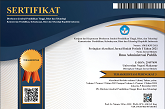Talent Management-Based Training Planning to Produce High-Performing Human Resources
(1) Universitas Pasundan, Indonesia
(*) Corresponding Author
DOI: https://doi.org/10.26858/jiap.v13i1.47154
Abstract
This study focuses on the process of talent management-based training planning, which is expected to generate high-performing human resources. The research method used is qualitative with a descriptive exploratory approach, with the research output being the stages of talent management-based training planning. The objective of this research is to design the stages of talent management-based training planning along with its supporting instruments, in order to produce high-performing human resources. The implementation of talent management in human resources training is one of the strategies that companies can use to obtain human resources with excellent performance quality, as well as to assess, train, and optimize the human resources owned by the company, where talent management can address retention or employees' desire to leave the organization. The impact of talent management implementation in the implementation of human resources training that adopts the DISC personality concept (Dominance, Influence, Steadiness, and Compliance) is expected to benefit both the company and the relevant employees, as follows: (1) Improving the business value of the company to shareholders; (2) Increasing customer satisfaction; (3) Enhancing the quality, productivity, and capabilities of human resources; (4) Boosting employee motivation and commitment to high performance; (5) Facilitating career development and mapping for employees; (7) Enhancing employees' contribution of knowledge to company objectives.
Keywords
Full Text:
PDFReferences
Agrawal, N. M., Khatri, N., & Srinivasan, R. (2012). Managing growth: Human resource management challenges facing the Indian software industry. Journal of World Business, 47(2), 159–166. https://doi.org/10.1016/j.jwb.2011.04.002
Al-Swidi, A. K., Gelaidan, H. M., & Saleh, R. M. (2021). The joint impact of green human resource management, leadership and organizational culture on employees’ green behaviour and organisational environmental performance. Journal of Cleaner Production, 316, 128112. https://doi.org/https://doi.org/10.1016/j.jclepro.2021.128112
Araujo, L. M. de, Priadana, S., Paramarta, V., & Sunarsi, D. (2021). Digital leadership in business organizations. International Journal of Educational Administration, Management, and Leadership, 2(1), 5–16. https://doi.org/10.51629/ijeamal.v2i1.18
Bag, S., Wood, L. C., Xu, L., Dhamija, P., & Kayikci, Y. (2020). Big data analytics as an operational excellence approach to enhance sustainable supply chain performance. Resources, Conservation and Recycling, 153, 104559. https://doi.org/https://doi.org/10.1016/j.resconrec.2019.104559
Buller, P. F., & McEvoy, G. M. (2012). Strategy, human resource management and performance: Sharpening line of sight. Human Resource Management Review, 22(1), 43–56.
Coetzer, A., Ryan, M. M., Susomrith, P., & Suseno, Y. (2017). Challenges in addressing professional competence expectations in human resource management courses. Asia Pacific Journal of Human Resources, 55(4), 454–475.
Creswell, J. W. (2010). Mapping the developing landscape of mixed methods research. SAGE Handbook of Mixed Methods in Social & Behavioral Research, 2, 45–68.
Creswell, J. W., & Creswell, J. D. (2017). Research design: Qualitative, quantitative, and mixed methods approaches. Sage publications.
Dewi, E. M. P., Djalal, N. M., & Siswanti, D. N. (2017). The Influence Of “Edufair” Psychoeducation To Improve Student Career Maturity At Y Senior High School Of Makassar. International Conference on Education, Science, Art and Technology, July, 75–87.
Ge, B., Ma, W., & Ji, J. (2022). Discipline Construction and Development of Medical Universities in Complex Environment under Digital Technology and Structural Equation Model. Journal of Healthcare Engineering, 2022, 6567625. https://doi.org/10.1155/2022/6567625
Hitka, M., Kucharčíková, A., Štarchoň, P., Balážová, Ž., Lukáč, M., & Stacho, Z. (2019). Knowledge and human capital as sustainable competitive advantage in human resource management. Sustainability, 11(18), 4985. https://doi.org/10.3390/su11184985
Jiang, D., Chen, Z., Liu, T., Zhu, H., Wang, S., & Chen, Q. (2022). Individual Creativity in Digital Transformation Enterprises: Knowledge and Ability, Which Is More Important? Frontiers in Psychology, 12, 734941. https://doi.org/10.3389/fpsyg.2021.734941
John W Creswell. (2013). Research Design Pendekatan Kualitatif, Kuantitatif, dan Mixed (Tiga). Pustaka Pelajar.
Kravariti, F., & Johnston, K. (2020). Talent management: a critical literature review and research agenda for public sector human resource management. Public Management Review, 22(1), 75–95.
Li, W., Liu, K., Belitski, M., Ghobadian, A., & O’Regan, N. (2016). e-Leadership through strategic alignment: An empirical study of small- and medium-sized enterprises in the digital age. Journal of Information Technology, 31(2), 185–206. https://doi.org/10.1057/jit.2016.10
Petersone, B., & Erzikova, E. (2016). Leadership and public relations in two emerging markets: A comparative study of communication management in Latvia and Russia. Public Relations Review, 42(1), 192–200. https://doi.org/https://doi.org/10.1016/j.pubrev.2015.09.007
Sheehan, M. (2018). Strategic talent management: A macro and micro analysis of current issues in hospitality and tourism. Worldwide Hospitality and Tourism Themes, 10(1), 28–41. https://doi.org/10.1108/WHATT-10-2017-0062
Tang, G., Wei, L.-Q., Snape, E., & Ng, Y. C. (2015). How effective human resource management promotes corporate entrepreneurship: evidence from China. The International Journal of Human Resource Management, 26(12), 1586–1601. https://doi.org/10.1080/09585192.2014.953973
Wesnawa, I. G. A., Sudirtha, I. G., Christiawan, P. I., Sulindawati, L. G. E., Dewi, N. A. W. T., & Wardhani, N. K. S. K. (2019). Minimalizing conflict on the management of border-area based on Nyamabraya. Humanities and Social Sciences Reviews, 7(6), 525–532. https://doi.org/10.18510/hssr.2019.7682
Article Metrics
Abstract view : 236 times | PDF view : 64 timesRefbacks
- There are currently no refbacks.
Copyright (c) 2023 Yusuf Arifin

This work is licensed under a Creative Commons Attribution 4.0 International License.
Diterbitkan oleh:
Program Studi Ilmu Administrasi Publik
Program Pascasarjana Universitas Negeri Makassar
JIAP Index By:

This work is licensed under a Creative Commons Attribution 4.0 International License.









